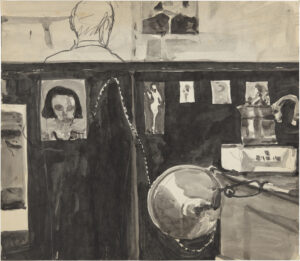Brooklyn Rail: Richard Diebenkorn: Figures and Faces

June 17, 2024
By Ekin Erkan
Richard Diebenkorn’s oeuvre is often divided into an early Abstract Expressionist period (ca. 1947–55), a figurative or representational period (ca. 1955–66), and finally a pair of later abstract periods (ca. 1967–88 and 1988–92). As most of the works in Richard Diebenkorn: Figures and Faces are drawn from the middle years of 1955–1967—with an outlier watercolor of three brightly painted derbies from 1984—the Van Doren Waxter exhibition need not concern itself with any dramatic artistic evolution or turn. Instead, as the title suggests, the show primarily deals with Diebenkorn’s distillation of the human form. This focus is clarified by the inclusion of several charcoal, ink, and graphite works on paper that depict Diebenkorn’s studio sitters and figure models. It is further underscored by two hand-written studio notes. One dated 1956–59 reads “when I select a subject to work from I seem to include one element or thing that is all wrong—which works against the total feeling or unity.” The other, written during the same period, deals with what Diebenkorn calls his “small heads,” cropped portraits of which nine are on view here. Reflecting on these works, Diebenkorn writes that his “only intention is to bring to them what to me is a human look.” He adds that this quality intuitively unspools, as it is “not preconceived. Often in mid-process I re-realize that this is all that I want from the canvas.”